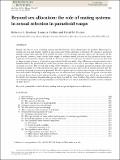Files in this item
Beyond sex allocation : the role of mating systems in sexual selection in parasitoid wasps
Item metadata
| dc.contributor.author | Boulton, Rebecca A. | |
| dc.contributor.author | Collins, Laura A. | |
| dc.contributor.author | Shuker, David M. | |
| dc.date.accessioned | 2014-08-19T10:01:03Z | |
| dc.date.available | 2014-08-19T10:01:03Z | |
| dc.date.issued | 2015-05 | |
| dc.identifier | 141542273 | |
| dc.identifier | 207a4b91-48c2-40e7-9820-29803be4901f | |
| dc.identifier | 24981603 | |
| dc.identifier | 000352818700013 | |
| dc.identifier | 84926679586 | |
| dc.identifier.citation | Boulton , R A , Collins , L A & Shuker , D M 2015 , ' Beyond sex allocation : the role of mating systems in sexual selection in parasitoid wasps ' , Biological Reviews of the Cambridge Philosophical Society , vol. 90 , no. 2 , pp. 599-627 . https://doi.org/10.1111/brv.12126 | en |
| dc.identifier.issn | 1464-7931 | |
| dc.identifier.uri | https://hdl.handle.net/10023/5193 | |
| dc.description | Funding: UK NERC Doctoral Training Grant | en |
| dc.description.abstract | Despite the diverse array of mating systems and life histories which characterise the parasitic Hymenoptera, sexual selection and sexual conflict in this taxon have been somewhat overlooked. For instance, parasitoid mating systems have typically been studied in terms of how mating structure affects sex allocation. In the past decade, however, some studies have sought to address sexual selection in the parasitoid wasps more explicitly and found that, despite the lack of obvious secondary sexual traits, sexual selection has the potential to shape a range of aspects of parasitoid reproductive behaviour and ecology. Moreover, various characteristics fundamental to the parasitoid way of life may provide innovative new ways to investigate different processes of sexual selection. The overall aim of this review therefore is to re-examine parasitoid biology with sexual selection in mind, for both parasitoid biologists and also researchers interested in sexual selection and the evolution of mating systems more generally. We will consider aspects of particular relevance that have already been well studied including local mating structure, sex allocation and sperm depletion. We go on to review what we already know about sexual selection in the parasitoid wasps and highlight areas which may prove fruitful for further investigation. In particular, sperm depletion and the costs of inbreeding under chromosomal sex determination provide novel opportunities for testing the role of direct and indirect benefits for the evolution of mate choice. | |
| dc.format.extent | 29 | |
| dc.format.extent | 1261595 | |
| dc.language.iso | eng | |
| dc.relation.ispartof | Biological Reviews of the Cambridge Philosophical Society | en |
| dc.subject | Parasitoid | en |
| dc.subject | Sexual selection | en |
| dc.subject | Mating system | en |
| dc.subject | Sperm depletion | en |
| dc.subject | Sex allocation | en |
| dc.subject | QH301 Biology | en |
| dc.subject.lcc | QH301 | en |
| dc.title | Beyond sex allocation : the role of mating systems in sexual selection in parasitoid wasps | en |
| dc.type | Journal item | en |
| dc.contributor.institution | University of St Andrews. School of Biology | en |
| dc.contributor.institution | University of St Andrews. Scottish Oceans Institute | en |
| dc.contributor.institution | University of St Andrews. Institute of Behavioural and Neural Sciences | en |
| dc.contributor.institution | University of St Andrews. Centre for Biological Diversity | en |
| dc.identifier.doi | https://doi.org/10.1111/brv.12126 | |
| dc.description.status | Peer reviewed | en |
This item appears in the following Collection(s)
Items in the St Andrews Research Repository are protected by copyright, with all rights reserved, unless otherwise indicated.

